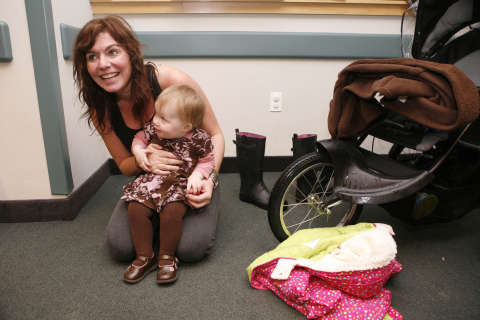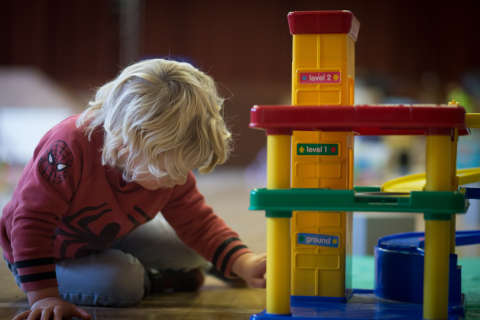The search for affordable, convenient, quality child care is a struggle in the Washington region. The five-part series Child Care Crisis will look at why it’s so hard to find care, and why costs are surpassing college tuition rates. The reports also examine the emotional toll the lack of child care takes on families.
WASHINGTON — One call was all it took for mom-to-be Jennifer Kauffman to nearly drop the phone.
“The very first day care we looked at quoted us $2,100 a month,” said Kauffman, a Northwest D.C. resident. “It was a shock to our system.”
The cost of child care in the U.S. is on the rise, surpassing the price of college tuition in 30 states and the District of Columbia.
This third report of the Child Care Crisis series dives into child care’s increasingly unaffordable price tag and how the industry is costing everyone involved.
More than a mortgage
In D.C., parents spend on average $22,658 a year (more than $1,800 a month) to send an infant to a child care center.
Costs in Virginia and Maryland ring in at $12,220 and $14,726, respectively, although those living closer to D.C. can expect to shell out more, as can those who opt for nanny care (between $37,000 and $41,600 a year).
“You hear of stories where people are paying another mortgage payment to send their kids to child care, and a lot of people try to just muscle through that,” said Kristin Schubert, managing director of the Healthy Children Portfolio at Robert Wood Johnson Foundation, a public health-focused organization.
But for most families, it isn’t an option: Both parents need to pull in a paycheck — even if the majority of one goes toward child care.
“It’s only the very wealthy who can afford to have one parent stay home or the very poor who actually can’t even afford child care because they don’t earn more than the child care,” said Leslie Morgan Steiner, who writes on parenting.
“We are talking about an issue that affects mainstream America,” she said.
Amy Ginn and Brian Stanton, of Kensington, Maryland, have a 4-year-old and a 2-year-old in a Montgomery County day care center. Combined, they pay $680 a week for child care, or $35,360 a year.
When their first child was born, the couple, both lawyers, had “a lot of savings.” By the time their second son arrived, their savings cushion was much smaller. To help afford the cost of child care, they’ve been mindful of their spending over the years.
“If you look at our house, it’s not super fancy, and I think we’re not house-poor for that reason. We knew we were going to have kids, and we knew somebody would have to watch them while we work,” Stanton said.
Why does it cost so much?
Where is all the money going? It costs a lot to provide care for young children. Regulations require small teacher-to-child ratios, typically 1:3 for infants and 1:4 for toddlers.
“Infant care is not cheap, and you kind of don’t want it to be cheap. It’s just really hard to pay for,” Stanton said.
While most American families can’t afford the high cost of child care, most providers can’t afford to live on the wages they make. According to a report published by DC Appleseed, a policy-focused advocacy organization, child care is one of the lowest paying professional fields.
“So we are subsidizing child care, or early care and learning, but on the backs of the teachers and the providers, which is really unsustainable,” said Brigid Schulte, director of Better Life Lab and The Good Life Initiative at the D.C.-based think tank New America.
The average income for child care workers in D.C. was $26,470 in 2013; approximately 45 percent of these D.C. employees didn’t receive employer-supported health benefits, DC Appleseed reports.
“I don’t know how day care workers send their kids to day care,” Stanton said.
There are programs in place to address Stanton’s concern. Low-income families can access child care through state-distributed subsidies. Those who qualify for SNAP and other government-run programs pay a discounted tuition rate on a sliding scale based on their income. The centers are then reimbursed by the state.
Robert Wood Johnson Foundation’s Schubert said the problem with subsidies is that those who need them most often don’t use them.
Some don’t know they exist; others don’t have the time to sift through the paperwork. “Never mind how to access them,” Schubert said.
“We have a child care crisis in this country, as far as access and affordability goes.”
The bottom line
Kauffman ended up finding a licensed day care center around the corner from her home for a fraction of the price she was initially quoted. Now, she pays $1,300 a month.
She said while the staff at her center are “loving and caring,” she can’t help but feel like the lower price tag came with a sacrifice. Kauffman admits that not all of the caregivers are up to date on best practices.
“One of the challenges is that I have to really be assertive and speak up and monitor and let folks know, ‘That might be a choking hazard,’ or, ‘That isn’t the best sleeping position for a baby’,” she said.
Overall, Kauffman said she is happy with her choice — and so is her bank account.
“I feel like we found this diamond in the rough, but by and large, most day cares are not affordable or accessible to many working families,” she said.
At one point in American history, accessible and affordable child care was almost a reality.
In 1971, Congress passed a bill to create a universal, federally funded child care system.

The legislation, which aimed to set up a network of day care centers free to low-income children and based on a sliding scale for others, received bipartisan support and made its way to President Richard Nixon’s desk for his signature.
But it was killed. Schulte said a general fear from politicians that a government-run child care program would “Sovietize the American family” was to blame.
“I think we really need to look beyond the ’70s and recognize that we need to catch up with where we are, and how do we make the systems work for the families and the structures that we have now,” Schulte said.
“We’ve decided as a society that (school) is a public good — that it’s the kind of society we want to be, that’s the kind of future we want to give to our kids to have them all well-educated and that’s worth our investment. And it’s time that we looked at 0-to-5 in that same way.”
The fourth report in the Child Care Crisis series explores the quality of child care in the D.C. area.








